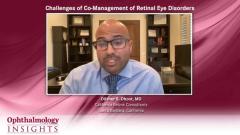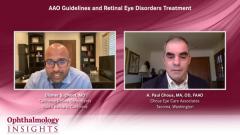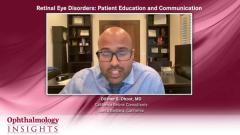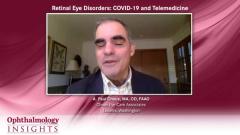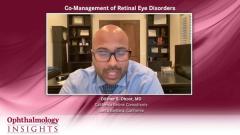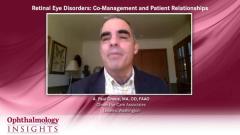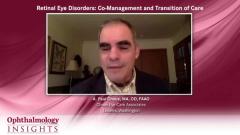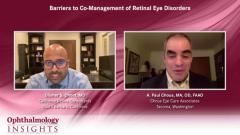
Anti-VEGF for the Treatment of Retinal Eye Disorders
Experts in the field of retinal eye disorders discuss the role of injectable anti-VEGF inhibitors and how they have changed the treatment landscape.
Episodes in this series

Dilsher S. Dhoot, MD: Let’s discuss the role of injectable anti-VEGF[anti–vascular endothelial growth factor] inhibitors and how they’ve changed the treatment landscape in retinal disorders. We touched on this a bit in the last question, but how do you think I’m making assumptions here, but you were practicing prior to 2006, right?
A. Paul Chous, MA, OD, FAAO: I was. I’m an old man now.
Dilsher S. Dhoot, MD: I didn’t want to say that. This is a great question for you. You’ve seen the landscape change. I started practicing in the era of anti-VEGF. I have a sense of how it changed things, but you truly saw it. Tell me from your perspective.
A. Paul Chous, MA, OD, FAAO: When I got out of optometry school in 1991 and people had neovascular AMD [age-related macular degeneration], the best you could hope for with macular photocoagulation was preventing vision from getting worse, right? Anti-VEGF has revolutionized the treatment landscape because a lot of patients get improved visual acuities, and that’s a big deal. One of the things that’s always important is why do most patients respond to anti-VEGF, but not all patients do? Are there characteristics? Are there lifestyle factors? What can we do collaboratively—optometry, retina, ophthalmology, and general—together to make therapies more beneficial. One of the things I’m interested in is a lot of research showing that if patients have untreated sleep disordered breathing, apnea and they’re not getting treated, with AMD and diabetes, they’re far less responsive to these anti-VEGF agents.
I hope we’re going to move in a direction with anti-VEGF drugs so we can identify the patients most likely to respond. Then we’ll consider newer therapies for those who don’t have a good response or are less likely to respond. You said you’ve been practicing in the anti-VEGF era. I assume a good portion of your day is spent injecting patients, right? Probably far more than in the operating room. Is that true of the typical retina specialist?
Dilsher S. Dhoot, MD: For sure. The vast majority of my time is in the clinic, and we inject all day. The anti-VEGF agents have revolutionized what we do. These drugs can maintain and improve visual acuity. As far as I like the thought of regarding sleep apnea, there’s been research looking at sleep apnea, and the role it plays on not just ocular conditions but also systemic conditions.
One other thing that is really important—and again, we lean on optometry for this—is early referral and treatment of conditions. We know that if we look at and think about the most common conditions we’ve discussed—wet macular degeneration, for example, you could treat a patient with wet macular degeneration when they’re just converted within a month of conversion. These patients tend to be presenting visions of better than 20/60 and maybe 20/30, 20/40. These patients can maintain good vision, right? We can improve them so they can potentially keep driving vision at 20/40.
We’ve seen in the RISE and RIDE diabetic macular edema studies and also in retinal vein occlusion [RVO] studies, such as BRAVO, that leaving center involving macular edema untreated over time results in the inability to gain visual acuity once the decision is made to treat. For example, in RISE and RIDE, patients were in the control arms for 2 years and then finally allowed to cross over into the treatment arm. At that point they gained vision, but it was much more modest than the counterparts that started with injections on day 0.
A. Paul Chous, MA, OD, FAAO: Yeah, they never caught up.
Dilsher S. Dhoot, MD: They never catch up. Even though the anatomy catches up, that’s what’s interesting. These patients are able to drive. For whatever reason, there are ultra-structural changes in the retina, and they don’t catch up. Early referral, early treatment can make a difference to get these patients to have the best vision they can, even in the current anti-VEGF era because none of the new agents has addressed any of this.
A. Paul Chous, MA, OD, FAAO: What about home monitoring? I’m a big proponent of using this preferential hyperacuity perimeter for patients with dry AMD who are at elevated risk for conversion. Should we be moving more in that direction because if months go by between when we see patients and they convert, we may not catch the patient on the day they convert. I have dozens of patients using PHP [hypertext preprocessor] at home, and I haven’t had a single person convert. I’ve had a couple of false positives, but I’d rather see that patient in case they do convert. There’s some evidence that if even in a false positive, ultimately those patients are more likely to convert to wet AMD. Is that something that you use in your practice, Dilsher?
Dilsher S. Dhoot, MD: Yeah, most definitely. I like the idea that it’s using technology to help find these patients sooner. There was an issue with insurance and payment on the device in the past. That may have been worked out recently, and then they cut the sales force, so that stunted the growth of that product. The next new thing is going to be potentially home monitoring, but potentially home OCT [optical coherence tomography] devices. That’s going to be fascinating. If you can monitor patients with an OCT in their homes via computer algorithms, that’s going to be a next-level thing. Hopefully the payers will be on board because it would be good for patient care.
A. Paul Chous, MA, OD, FAAO: It’s a different target audience with home OCT. It’s people who have already had a choroidal neovascular membrane, presumably?
Dilsher S. Dhoot, MD:Potentially, but if they’re able to scale these machines, you can see how it could also be a device that could use the screen for wet AMD conversion as well.
TRANSCRIPT EDITED FOR CLARITY
Newsletter
Don’t miss out—get Ophthalmology Times updates on the latest clinical advancements and expert interviews, straight to your inbox.


